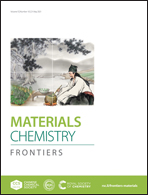Importance of molecular rigidity on reducing the energy losses in organic solar cells: implication from geometric relaxations of A–D–A electron acceptors†
Abstract
Because of the emergence of small-molecule acceptors with acceptor–donor–acceptor (A–D–A) structures, organic solar cells (OSCs) have developed rapidly in recent years. Currently, the power conversion efficiencies (PCEs) of the OSCs based on A–D–A acceptors exceed 18%, much higher than those of the fullerene-based OSCs. Nonetheless, the photovoltaic performances of OSCs still lag behind inorganic and perovskite solar cells due to more serious energy losses. Herein, in order to reveal the energy loss mechanisms at the molecular level, we have investigated the geometric structures of the ground (S0), excited (S1), and anionic (A−) states as well as the mutual transitions among these electronic states for a series of A–D–A acceptors with fully fused rigid or non-fused flexible donor units. The results show that the fully fused molecules have planar backbones in all the electronic states, while the non-fused molecules are much distorted at S0, and become less twisted at S1 and A−. Consequently, compared with the non-fused A–D–A acceptors, the fused ones generally have smaller reorganization energies for each electronic transition, leading to reduced voltage and current losses. In addition, extending the donor unit lengths is beneficial for reducing charge recombination and facilitating charge transport. These results indicate that design and optimization of large fused A–D–A acceptors would be an effective way to further improve the organic photovoltaic performance.



 Please wait while we load your content...
Please wait while we load your content...